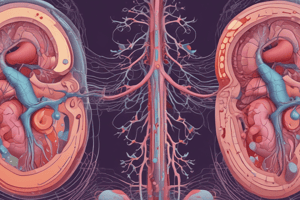Podcast
Questions and Answers
What are the three main categories of AKI classified based on the location of the underlying cause?
What are the three main categories of AKI classified based on the location of the underlying cause?
Prerenal AKI, Renal AKI, and Post-renal AKI
What is the main cause of Prerenal AKI?
What is the main cause of Prerenal AKI?
Decreased blood flow into the kidneys
What is the mechanism of action of NSAIDs in decreasing renal blood flow?
What is the mechanism of action of NSAIDs in decreasing renal blood flow?
Inhibiting COX and lipoxygenases, leading to decreased prostaglandin production
What is the role of prostaglandins in maintaining renal blood flow?
What is the role of prostaglandins in maintaining renal blood flow?
What are the common risk factors for AKI?
What are the common risk factors for AKI?
What is the pharmacological role of a pharmacist in managing AKI?
What is the pharmacological role of a pharmacist in managing AKI?
What is the non-pharmacological role of a pharmacist in managing AKI?
What is the non-pharmacological role of a pharmacist in managing AKI?
What are the limitations of the Cockcroft-Gault equation?
What are the limitations of the Cockcroft-Gault equation?
What is the effect of ACEi/ARBs on renal blood flow?
What is the effect of ACEi/ARBs on renal blood flow?
What is the purpose of monitoring serum creatinine in AKI?
What is the purpose of monitoring serum creatinine in AKI?
Study Notes
Acute Kidney Injury (AKI)
-
AKI is diagnosed by an absolute increase in serum creatinine (sCr)
-
Classified into three main categories based on the location of the underlying cause:
Prerenal AKI
- Causes: decrease blood flow into the kidneys
- Examples: hypovolaemia (low volume of fluid), loss of peripheral resistance, reduced cardiac output, renovascular obstruction
- Examples of causes: dehydration, burning trauma, hypotension, heart failure, thrombosis
Renal AKI
- Causes: damage to nephrons or surrounding factors
- Examples: pre-glomerular (small arteries), glomerular (capillary network), post-glomerular (tubules)
- Examples of causes: hypertension, glomerulonephritis, tubular necrosis
Post-renal AKI
- Causes: obstruction of urinary outflow
- Examples: ureteric obstruction, bladder outflow obstruction, infections
- Examples of causes: kidney stones, benign prostatic hyperplasia, inflammation of the kidney
Risk Factors for AKI
- Advanced age
- Diabetes
- Chronic kidney disease (CKD)
- Sepsis
- Hypotension/shock
- Dehydration, burn trauma
- Urinary tract infection (UTI)
Pharmacist's Role in Managing AKI
- Pharmacological management:
- Discontinue nephrotoxic drugs
- Treat infections early
- Monitor blood pressure
- Adjust doses
- Non-pharmacological management:
- Recognize high-risk patients
- Assess fluid status/balance
- Monitor renal function
Medications Affecting Renal Function
- NSAIDs:
- Decrease renal blood flow and eGFR
- Promote fluid retention
- Inhibit prostaglandin synthesis
- ACEIs/ARBs:
- Decrease renal blood flow and eGFR
- Cause hyperkalemia
- Diuretics:
- Cause increased urine production, exacerbating hypovolaemia
- Iodine-based contrast media:
- Decrease renal blood flow and eGFR
Mechanism of Action (MoA)
- NSAIDs: inhibit COX and lipoxygenases, leading to decreased prostaglandin release and inflammation
- ACEIs/ARBs: inhibit conversion of angiotensin I to angiotensin II, reducing vasoconstriction and aldosterone production
Prostaglandins
- Produced in the kidney: PGI2, PGE1, PGE2
- Increase renal blood flow and eGFR by vasodilating afferent arteriole
- Released in response to dehydration, acute stress, angiotensin II, and sympathetic nervous system (SNS) stimulation
- Used to treat renal ischemia by preventing excessive reduction in GFR and renal blood flow
Renal Function Calculations
- Cockcroft-Gault equation:
- Calculates estimated creatinine clearance in micromol/L
- Used for elderly patients, bodybuilders, and obese individuals
- Requires ideal body weight (IBW) and dose determining weight (DDW) formulation
- MDRD equation:
- Calculates eGFR
- Affected by muscle mass (reduced muscle mass leads to overestimation, increased muscle mass leads to underestimation)
Studying That Suits You
Use AI to generate personalized quizzes and flashcards to suit your learning preferences.
Description
Learn about the three stages of Acute Kidney Injury (AKI) and its causes, including Prerenal, Renal, and Post-renal AKI. Understand the factors that lead to AKI, such as hypovolaemia, loss of peripheral resistance, and reduced cardiac output.




